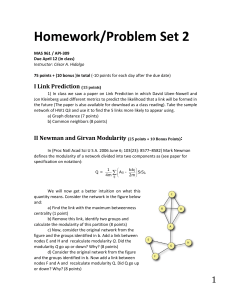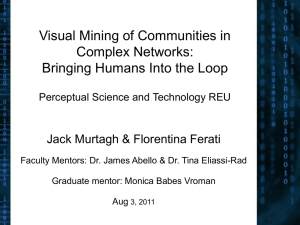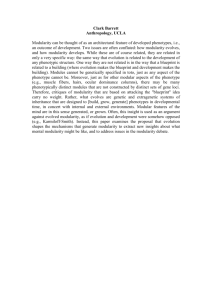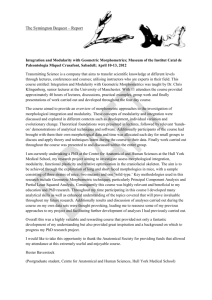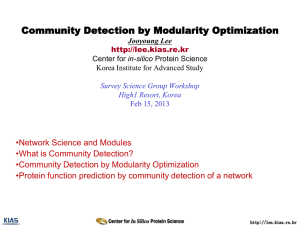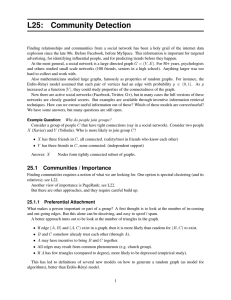www.ijecs.in International Journal Of Engineering And Computer Science ISSN:2319-7242
advertisement
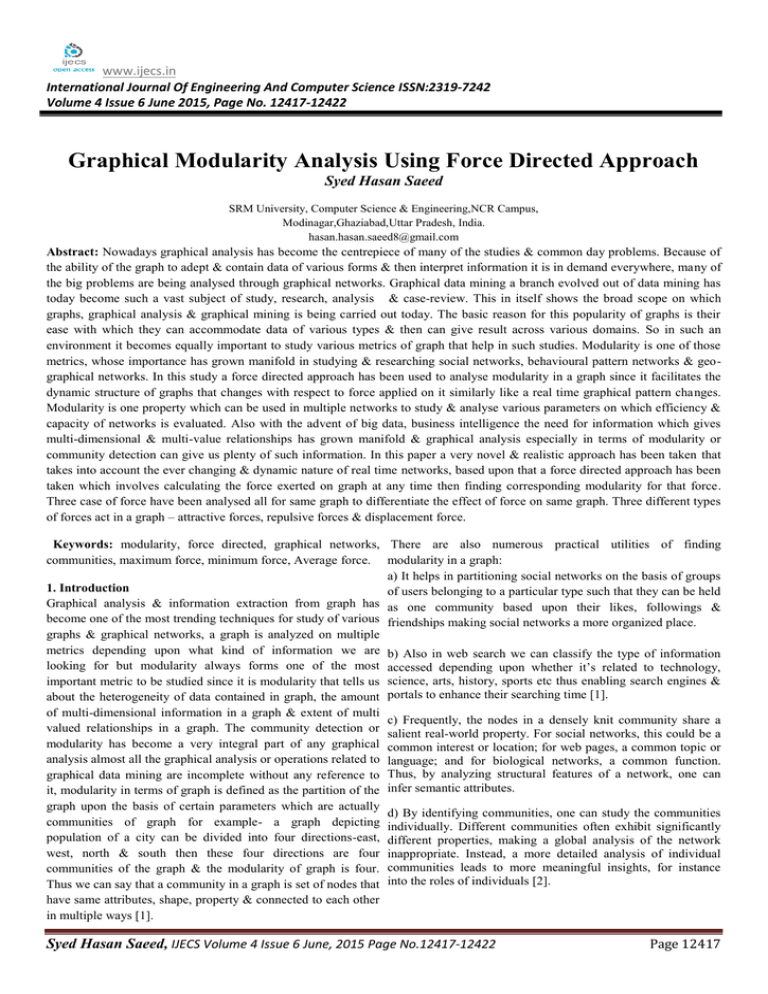
www.ijecs.in
International Journal Of Engineering And Computer Science ISSN:2319-7242
Volume 4 Issue 6 June 2015, Page No. 12417-12422
Graphical Modularity Analysis Using Force Directed Approach
Syed Hasan Saeed
SRM University, Computer Science & Engineering,NCR Campus,
Modinagar,Ghaziabad,Uttar Pradesh, India.
hasan.hasan.saeed8@gmail.com
Abstract: Nowadays graphical analysis has become the centrepiece of many of the studies & common day problems. Because of
the ability of the graph to adept & contain data of various forms & then interpret information it is in demand everywhere, many of
the big problems are being analysed through graphical networks. Graphical data mining a branch evolved out of data mining has
today become such a vast subject of study, research, analysis & case-review. This in itself shows the broad scope on which
graphs, graphical analysis & graphical mining is being carried out today. The basic reason for this popularity of graphs is their
ease with which they can accommodate data of various types & then can give result across various domains. So in such an
environment it becomes equally important to study various metrics of graph that help in such studies. Modularity is one of those
metrics, whose importance has grown manifold in studying & researching social networks, behavioural pattern networks & geographical networks. In this study a force directed approach has been used to analyse modularity in a graph since it facilitates the
dynamic structure of graphs that changes with respect to force applied on it similarly like a real time graphical pattern changes.
Modularity is one property which can be used in multiple networks to study & analyse various parameters on which efficiency &
capacity of networks is evaluated. Also with the advent of big data, business intelligence the need for information which gives
multi-dimensional & multi-value relationships has grown manifold & graphical analysis especially in terms of modularity or
community detection can give us plenty of such information. In this paper a very novel & realistic approach has been taken that
takes into account the ever changing & dynamic nature of real time networks, based upon that a force directed approach has been
taken which involves calculating the force exerted on graph at any time then finding corresponding modularity for that force.
Three case of force have been analysed all for same graph to differentiate the effect of force on same graph. Three different types
of forces act in a graph – attractive forces, repulsive forces & displacement force.
Keywords: modularity, force directed, graphical networks, There are also numerous practical utilities of finding
communities, maximum force, minimum force, Average force. modularity in a graph:
a) It helps in partitioning social networks on the basis of groups
1. Introduction
of users belonging to a particular type such that they can be held
Graphical analysis & information extraction from graph has as one community based upon their likes, followings &
become one of the most trending techniques for study of various friendships making social networks a more organized place.
graphs & graphical networks, a graph is analyzed on multiple
metrics depending upon what kind of information we are b) Also in web search we can classify the type of information
looking for but modularity always forms one of the most accessed depending upon whether it’s related to technology,
important metric to be studied since it is modularity that tells us science, arts, history, sports etc thus enabling search engines &
about the heterogeneity of data contained in graph, the amount portals to enhance their searching time [1].
of multi-dimensional information in a graph & extent of multi
c) Frequently, the nodes in a densely knit community share a
valued relationships in a graph. The community detection or salient real-world property. For social networks, this could be a
modularity has become a very integral part of any graphical common interest or location; for web pages, a common topic or
analysis almost all the graphical analysis or operations related to language; and for biological networks, a common function.
graphical data mining are incomplete without any reference to Thus, by analyzing structural features of a network, one can
it, modularity in terms of graph is defined as the partition of the infer semantic attributes.
graph upon the basis of certain parameters which are actually
d) By identifying communities, one can study the communities
communities of graph for example- a graph depicting individually. Different communities often exhibit significantly
population of a city can be divided into four directions-east, different properties, making a global analysis of the network
west, north & south then these four directions are four inappropriate. Instead, a more detailed analysis of individual
communities of the graph & the modularity of graph is four. communities leads to more meaningful insights, for instance
Thus we can say that a community in a graph is set of nodes that into the roles of individuals [2].
have same attributes, shape, property & connected to each other
in multiple ways [1].
Syed Hasan Saeed, IJECS Volume 4 Issue 6 June, 2015 Page No.12417-12422
Page 12417
2. Nature Of Work
The present paper deals with enhancing modularity of a graph
by the use of Fruchterman & Reingold algorithm based upon the
principle of force directed algorithm. Essentially this algorithm
has its roots in physical system or to say in simple terms it has
been derived from mechanical systems. When described in
mechanical system it is like laying out a graph in physical plain
where nodes are replaced by steel rings & edges are replaced by
springs. The vertices are placed in some initial order such that
they are not too far from each other & also to let the spring
forces on the rings achieve a minimal energy state [3]-[4].
The two basic principles that have been kept in regards for this
approach are :
a) Vertices that are connected through an edge should be drawn
near to each other.
D
E
Community 1
F
G
Community 2
H
Fig 1.3 Dense Graph with more communities.
b) But two vertices should not be too close such that they repel
each other[3].
Steel
Ring
s
3. Previous Work
The previous work that has been done under this subject is of
two categories:
i) Modularity maximization for community detection.
ii) Statistical & min-max model of finding modularity.
ll
r
Springs
Steel
Ring
s
Steel
Ring
s
ll
ll
Fig 1.1 physical model of force directed
approach.
The position of vertices placing will depend upon the nature &
size of the graphr if the graph is large then we arer looking for
higher number of communities so vertices will be nearer to each
other whereas in case of smaller graph it will be vice-versa.
Also how many communities we find in a graph depends upon
the strength of forces acting in the graph if there is high amount
of force then less chance of equilibrium being achieved so lesser
communities whereas if force acting in the graph is less then
more chances of equilibrium therefore more communities can be
detected [3]-[4]-[5]-[6].
A
B
Community 1
C
Fig 1.2 Sparse Graph with lesser communities.
3.1. Modularity Maximization Method
In this method the approach used was the technique of solving
and rounding fractional mathematical programs to the problem
of community discovery, and propose two new algorithms for
finding modularity-maximizing clustering. Two major
algorithms have been used in this approach.
The first algorithm was based on a linear programming (LP)
relaxation of an integer programming (IP) formulation. The LP
relaxation put nodes “partially in the same cluster”. A
“rounding” procedure was used due to Charikar [7] for the
problem of Correlation Clustering. The idea of the algorithm is
to interpret “partial membership of the same cluster” as a
distance metric, and group together nearby nodes [7]-[8].
The second algorithm is based on a vector programming (VP)
relaxation of a quadratic program (QP). It recursively splits one
partition into two smaller partitions while a better modularity
can be obtained. It is similar in spirit to an approach recently
proposed by Newman [9, 10], which repeatedly divides clusters
based on the first eigenvector of the modularity matrix.
Newman’s approach can be thought of as embedding nodes in
the interval [−1, 1], and then cutting the interval in the middle.
The VP embeds nodes on the surface of a high-dimensional
hyper sphere, which is then randomly cut into two halves
containing the nodes. The approach is thus very similar to the
algorithm for Maximum Cut due to Goemans and Williamson
[11].
The method of modularity maximization is further classified
into two types on which previously work has been done :
3.1.1 The LP Rounding Algorithm
Our LP rounding algorithm is essentially identical to one
proposed by Charikar [7] for the Correlation Clustering
problem. In correlation clustering, one is given an undirected
graph
G = (V,E) with each edge labelled either ‘+’ (modelling
similarity between endpoints) or ‘−’ (modelling dissimilarity).
Syed Hasan Saeed, IJECS Volume 4 Issue 6 June, 2015 Page No.12417-12422
Page 12418
The goal is to partition the graph into clusters such that few
vertex pairs are classified incorrectly. Formally, in the MinDisagree version of the problem, the goal is to minimize the
number of ‘−’ edges inside clusters plus the number of ‘+’ edges
between clusters. In the Max-Agree version, which is not as
relevant to our approach, the goal is to maximize the number of
‘+’ edges inside clusters plus the number of ‘−’ edges between
clusters. Using the same 0-1 variables xu,v as we did above,
Charikar [7] formulate Min-Disagree as follows [9]-[10]-[12].
Minimize P(u,v)∈E+ xu,v +P(u,v)∈E− (1 − xu,v) subject to xu,w _
xu,v + xv,w for all u, v,w xu,v 2 {0, 1} for all u, v, where E+
and E− denote the sets of edges labelled ‘+’ and ‘−’,
respectively. The objective can be rewritten as |E+|−P(u,v)∈E
μu,v(1−xu,v), where μu,v is 1 for ‘+’ edges and -1 for ‘−’ edges.
The objective is minimized when P(u,v)∈E μu,v(1−xu,v) is
maximized; thus, except for the shift by the constant |E+|, MinDegree takes on the same form as modularity maximization
with mu,v = μu,v[10]-[13].
3.1.2 Vector Programming Based Algorithm
This algorithm used a ‘heirarichal clustering’, In the sense that
the clustering is obtained by repeatedly finding a near-optimal
division of a larger cluster. For two reasons, this clustering is
not truly hierarchical: First, we do not seek to optimize a global
function of the entire hierarchy, but rather optimize each split
locally. Second,
unrelated pairs from the user defined unrelated pair set within
groups at the same time, therefore we named it Max-Min
Modularity. But maximizing the edge number within groups
does not automatically minimize the unrelated pair number, e.g.,
if we have no network knowledge, thus have no related pairs,
and unrelated pairs as disconnected node pairs, consider a node
that only connects one member of a community with size n,
maximizing the within-group edge number by including that
node in this community would increase the unrelated pair
number by n – 1. [17].
4. Present Work Undertaken
As we saw with the above both approaches that both of them
requires a lot of preliminaries parameters for analysing
modularity in any graph as well as lot of calculations have to be
taken into account.
So the present approach is much more simplified version of
finding modularity or community detection in any graph. The
approach involves application of Fruchterman Reingold [3]
algorithm on gephi tool to analyze modularity. The basic
principle involved here is that the algorithm gives graph a
circular shape so once the graph attains a final spherical shape
the nodes that are in central are connected nodes with much
higher degree connectivity & part of multiple communities.
Whereas the nodes that are formed on outer rings are less
connected nodes with lesser degree of connectivity. This
alignment of nodes in a graph in spherical shape forms the basis
of this research & study, the following figure explains how
nodes are formed in this approach.
we again apply a local search based post-processing step to
improve the solution, thus rearranging the clusters. Despite
multiple recently proposed hierarchical clustering algorithms,
there is far from general agreement on what objective functions
would capture a “good” hierarchical clustering. Indeed, different
objective functions can lead to significantly different clustering.
While our clustering is not truly hierarchical, the order and
position of the splits that it produces still reveal much high level
of information about the network and its clusters. This
approach is aimed for the best division at each level
individually, requiring a partition into two clusters at each level.
Clusters are recursively subdivided as long as an improvement
is possible. Thus, a solution hinges on being able to find a good
Fig 1.4 Alignment of nodes in the graph showing U.S airline
partition of a given graph into two communities [14]-[15].
flight plan.
3.2 Max-Min Modularity Method
The idea of MM Modularity is based on the intuition that a good
division of a network into communities is not merely one in
which the number of edges between groups is smaller than
expected, it is also one in which the number of unrelated pairs
within group is smaller than expected. Only if both the numbers
of between-group edges and within-group unrelated pairs are
significantly lower than would be expected purely by chance,
can we justify claim to have found significant community
structure. Equivalently, we can examine the number of edges
within communities and unrelated pairs between communities
and look for divisions of the network in which this number is
higher than expected. These two approaches are equivalent
since the total number of edges/pairs is fixed and any
edges/pairs that do not lie between communities must
necessarily lie inside one of them [16].
Generally speaking, our evaluation attempts to maximize the
number of edges within groups and minimize the number of
In the above figure the nodes that are at centre are highly
connected nodes having higher chance of being found out in
community detection whereas the fringe nodes on outer lines are
less connected nodes with lesser chance of being found out in a
community.
Since the algorithm that has been used here is a force directed
algorithm so the amount of force that exists in a graph or in
other words that is exerted on graph plays a major role in
deciding the number of communities that we can get for a
graph. So the major emphasis that has been given here is to
analyse how the force exertion in different conditions results in
founding of different set of communities for same graph.
The three major kind of forces that exists in this algorithm is
attraction, repulsion & displacement.
a)ATTRACTIVE FORCES : Force acting between nodes that
are connected to each other.
b)REPULSIVE FORCES : Force acting between nodes that are
disconnected to each other.
Syed Hasan Saeed, IJECS Volume 4 Issue 6 June, 2015 Page No.12417-12422
Page 12419
c)DISPLACEMENT FORCES : Force that finally settles the
node after above two forces have acted upon it.
Attractive Forces
A
Connected Nodes
B
Fig. 1.5
Repulsive Forces
A
Disconnected Nodes
Fig. 1.6
A
Displacement force
Connected Nodes
B
BA
BB
Fig. 1.8 Showing average force taken for calculation. Force =
1.0 [average]
B
BA
B
Disconnected Node
C
Fig. 1.7
Fig. 1.9 Showing four communities obtained for average force
So basically three different cases where used for this study :
calculation.
i)Average Force Calculation : In this case we try to find out the
modularity or number of communities founded when all forces
acting where of average nature.
ii)Maximum Force Calculation : In this case we try to find out
the modularity or number of communities founded when all
forces acting where of maximum nature.
iii)Minimum Force Calculation : In this case we try to find out
the modularity or number of communities founded when all
forces acting where of minimum nature.
5. Results
The karate club [18] interaction dataset has been taken for the
purpose of analysing modularity for different cases. The
communities obtained where according to interactions taking
place in communities & force acting in the graph
5.1 Case 1 - Average force Modularity
Fig. 1.10 Graphical representation of four communities obtained
5.1.1 Result Analysis
The result for average force shows that when average amount of
force is acting within the graph then number of communities
that will be detected is also in medium range.
Syed Hasan Saeed, IJECS Volume 4 Issue 6 June, 2015 Page No.12417-12422
Page 12420
Here we took force resolution= 1.0, so we got 4 communities
which are represented in graphical manner through four
different colours. In graphical format we can see the spherical
alignment in which the algorithm adapts itself has connected
communities like red & blue at centre whereas dispersed
communities like violet & green are more settled on outer areas.
Thus establishing the fact which formed the basis of this study.
5.2 Case 2 - Minimum force Modularity
5.2.1 Result Analysis
The result for minimum force shows that when minimum
amount of force is acting within the graph then number of
communities that will be detected is in maximum range. This
inverse relationship between force applied & number of
communities detected is because there is a direct relationship
between nodes movement due to application of force, so when
there is minimum force movement nodes do not change their
position & they form maximum communities.
In this case the force resolution was taken 0.5 & nine
communities were detected. The graphical representation
depicts all of them but since the number of communities is
much more this time so we do not get such a strong connected
& disconnected node contrast like we got in average force case.
5.3 Case 3 - Maximum force Modularity
Fig. 1.11 Showing minimum force taken for calculation.
Force = 0.5 [minimum]
Fig. 1.14 Showing maximum force taken for calculation.
Force = 1.6 [maximum]
Fig. 1.12 Showing nine communities obtained for minimum
force calculation.
Fig. 1.15 Showing two communities obtained for maximum
force calculation.
Fig. 1.13 Graphical representation of nine communities
obtained.
Syed Hasan Saeed, IJECS Volume 4 Issue 6 June, 2015 Page No.12417-12422
Page 12421
Fig. 1.16 Graphical representation of two communities
obtained.
5.3.1 Result Analysis
The result for maximum force shows that when maximum
amount of force is acting within the graph then number of
communities that will be detected is in minimum range. The
relationship is inverse & vice-versa to case of minimum forces.
Reason is same only the order gets changed, because this time
the force acting in graph leads to change in position or
displacement of nodes thus they are not in their fixed position &
very few communities are detected. Here we used force
resolution = 1.6 but only two communities were obtained. It is
also a case of submerging of communities leading to smaller
communities getting dissolved & only larger communities
remaining.
6. Conclusion
So we saw that we got three different results for three different
kind of force intensity, but all belonging to same graph. For all
the cases the .count of modularity or number of communities
changes. In first case when force was “average” we got “four
communities” since there was not much distortion in the graph
& we got optimum number of communities. In second case
when there was “minimum force” acting in the graph we got
“nine communities” which were maximum this happened
because the amount of distortion happening in the graph was
minimum so all nodes retained their position & hence their
communities, In third case it was vice-versa of second case
because of maximum distortion nodes changed their position a
lot & in last only “two communities” could be found which
were minimum.
Thus the study showed that in force directed graph the amount
of force exerting in the graph plays a major role in the forming
of communities, the lesser the force, distortion in graph is also
less & more communities are founded, whereas increasing force
leads to inverse changes. In case of average forces the results
also lie between maximum & minimum.
ModularityMaximization using GRASP with Path
Relinking”.
[3] Thomas M. J. Fruchterman & Edward M.
Reingold,”Graph
Drawing
by
Force-directed
Placement”, Department of Computer Science,
University of Illinois at Urbana-Champaign, 1304
W.Springfield Avenue, Urbana, IL 61801-2987, U.S.A.
[4] Boštjan Pajntar,” OVERVIEW OF ALGORITHMS
FOR GRAPH DRAWING” Department of Knowledge
Technologies,Jozef Stafan Institute,Jamova 39, 1000
Ljubljana, Slovenia.
[5] P. Eades and R. Tamassia, “Algorithms for drawing
graphs: an annotated bibliography”, Networks,to
appear.
[6] P. Eades, ‘A heuristic for graph drawing’, Congressus
Nutnerantiunt, 42, 149–160 (1984).7]
[7] David Kempe1, Gaurav Agarwal 2,” ModularityMaximizing Graph Communities via Mathematical
Programming”,1Computer
Science
Department,
University of Southern California, Los Angeles, CA
90089, 2.Google Inc,Hyderabad,India.
[8] M. Charikar, V. Guruswami, and A. Wirth. “Clustering
with qualitative information”. Journal of Computer and
System Sciences, pages 360–383, 2005.
[9] Santo Fortunato,”Complex Networks and Systems”
Lagrange Laboratory, ISI Foundation, Viale S. Severo
65, 10133, Torino,I-ITALY.]
[10] M. Newman. “Finding community structure in
networks using the eigenvectors of matrices”. Physical
Review E, 74,2006.
[11] M. Girvan andM. Newman. “Community structure in
social and biological networks”. Proc. Natl. Acad. Sci.
USA, 99,2002.
[12] M. Newman. “Modularity and community structure in
networks”. Proc. Natl. Acad. Sci. USA, 103:8577–
8582, 2006.
[13] M. Charikar, V. Guruswami, and “ A. Wirth.
Clustering with qualitative information”. Journal of
Computer and System Sciences, pages 360–383, 2005.
[14] N. Bansal, A. Blum, and S. Chawla. “Correlation
clustering”,Machine Learning, , 56:89–113, 2004.
[15] M. E. J. Newman. Finding community structure in
networks using the eigenvectors of matrices. Physical
Review E, 74, 2006.
[16] Jiyang
Chen,Osmar
R.
Za•and
Randy
Goebel,”Detecting Communities in Social Networks
using Max-Min Modularit”.
[17] J. Scripps, P.-N. Tan, and A.-H. Esfahanian.
“Exploration of link structure and community-based
node roles in network”. In ICDM, 2007.
[18] Zachary’s Karate Club data set, network data
repository,
university
of
California,
networkdata.ics.uci.edu.
8. Author Profile
Syed Hasan Saeed received B.tech degree in Computer science
& Engineering in 2013 from GBTU University. At present he is
[1] Ulrik Brandes, Daniel Delling, Marco Gaertler, Robert pursuing M.tech from SRM University, NCR Campus. He can
G¨orke,”On Modularity Clustering”.
be contacted at hasan.hasan.saeed8@gmail.com
[2] Mari´a
C.
V.
Nascimento
and
Leonidas
S.Pitsoulis,”Community
Detection
by
7. References
Syed Hasan Saeed, IJECS Volume 4 Issue 6 June, 2015 Page No.12417-12422
Page 12422
